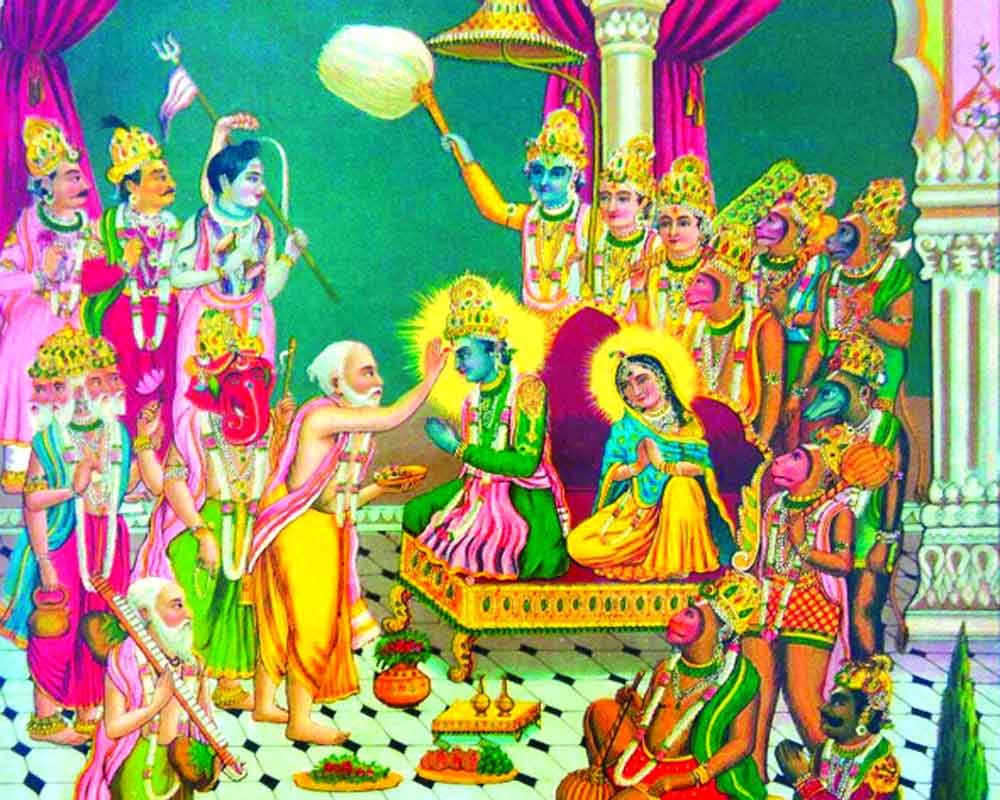Valmiki’s Ramayana gives us a vivid picture of what Ram Rajya was. It was an efficiently governed welfare State with a strong and responsive Government that cared for all
The ethos of the Hindu polity has been derived from Vedic philosophy, which placed the practice of dharma above everything else. In the Vedic ideal, therefore, there are clear, well-laid-out constraints upon the powers a ruler can wield. It is out of this Vedic idea that the concept of the Ram Rajya was born during the era of Shri Ramachandra, and which is held out the ideal state for the benefit of people. Thinkers and political leaders in India have venerated the Ram Rajya as the ideal to be striven for, and it resonates as the ideal polity in the minds of most Indians.
The realities of human nature do not lend themselves easily to the achievement of such a polity. Realpolitik has taken precedence over any single-minded pursuit of the ideal state. This is exemplified in the Western world by Niccolò Machiavelli and in India by Chanakya, the guru of Emperor Chandragupta Maurya around 310 BC. Machiavelli looked at the pursuit and perseverance of political power, while Chanakya along with Chandragupta, was the co-founder of one of the largest and most powerful empires of the ancient world. His Arthashastra remains even today a seminal treatise on governance.
The pursuit of realpolitik for a strong and powerful, yet ideal and welfare-oriented state precedes even Chanakya. Krishna Rajya, therefore, is as important, as the Ram Rajya that preceded it. Much can be gleaned of the political institutions of the Ramayana era, loosely termed as Ram Rajya, from Valmiki’s Ramayana. These provide researchers, scholars and lay readers with some idea of what Ram Rajya might have been like, notwithstanding counter-arguments that Valmiki’s treatment of the political system of his age might have been more ideal than what actually materialized on the ground. As the sage Valmiki was a contemporary of Rama, the polity he described in the Ramayana may be taken to be reflective of the prevailing political system of governance in the era they both lived.
Valmiki’s work embodies the extant aspects of the ancient Indian polity of the Treta Yuga, the era of Rama. A deeper look at the state of the polity during Vedic times reveals parallels between the Vedic and Ramayana’s ideas of government. Seminal work on the likely nature and shape of the polity during the period of Rama was done by Ms Pazhamaneri Chandrashekhar Dharma (1907-1977), a highly accomplished academic and scholar, and former lecturer at the Banaras Hindu University (BHU). Ms. Dharma’s work The Ramayana Polity likely remains the only work of research on what the structure of governance and administration in the period of Rama must have been like.
There is a dearth of information on Ram Rajya. The irony is compounded by the fact that there are ample references in Valmiki’s Ramayana itself, which deal with the socio-political conditions of the Treta Yuga. It is indeed possible to collate such details to derive a picture of the polity that existed during this period. Western interpretations either treat the Ramayana as a ‘myth’ or an allegorical representation, or talk of a so-called ‘Aryan conquest’ of southern India. The Ramayana however, nowhere mentions any founding or extension of any ‘Aryan realm’ in south India. Indeed, there is not even a hint of Rama even attempting any civilizational change outside Ayodhya. In the light of research of later years and ever-new findings on India’s civilizational history, most Western theories and their Indian reproductions are open to questioning and rebuttal.
Valmiki’s Ramayana gives us insights into social life—habits, customs, attire, ceremonies, beliefs, castes, tribes, forms of government, the status of women, education, science, commerce, industry, navigation, etc. The term ‘Aryan’ one comes across in this context is used solely for nobility of character and loftiness of values, and not for any particular race or community. The Ramayana teaches not only the geography of India but also about other countries. The land ruled by the Ikshvaku-Raghu lineage and other dynasties in the north (the dynasty in which Rama was born) stretched from the Panchnad (today’s Punjab) in the northwest to Videha, Mithila and Anga in the east (all in present-day Bihar), to Saurashtra in the southwest and to the great Dandaka forest in the south (present-day Andhra Pradesh). The other major communities mentioned in the Ramayana are the Vanaras o and the Rakshasas, who ruled Lanka.
In governance, the monarchy described in the Ramayana—and here the Ikshvaku-Raghu Dynasty’s monarchy is the most prominent was not an absolute monarchy in any sense. The powers of the emperor or samrat were circumscribed by institutions like the sabha (royal assembly) that comprised princes, ministers, advisors and military officials. The sage advice and counsel of rishis is a striking feature of the epic age in India, a pointer to the fact that ancient Hindu society has always accorded primacy to spiritual and dharmic authority over the temporal one.
Apart from the governing body advising the king, the state also had representative organisations, called the Paura-Janapada in the Ramayana. Paura means the representatives of the citizens within the capital while the Janapada are the representatives of the people in the countryside, both organs suggesting decentralization of power in Ram Rajya. A premium was placed on military organisation and power. It is a measure of the political efficacy of Rama’s rule that following his defeat of Ravana, India under him did not have to face any serious military challenge from any other quarter, nor was there any social upheaval that sometimes follows a major conflict. The administration of Ram Rajya will be compared with the administrations of modern times too.
(The writer is a well-known columnist, an author, and a former member of the Rajya Sabha. The views expressed are personal)


























